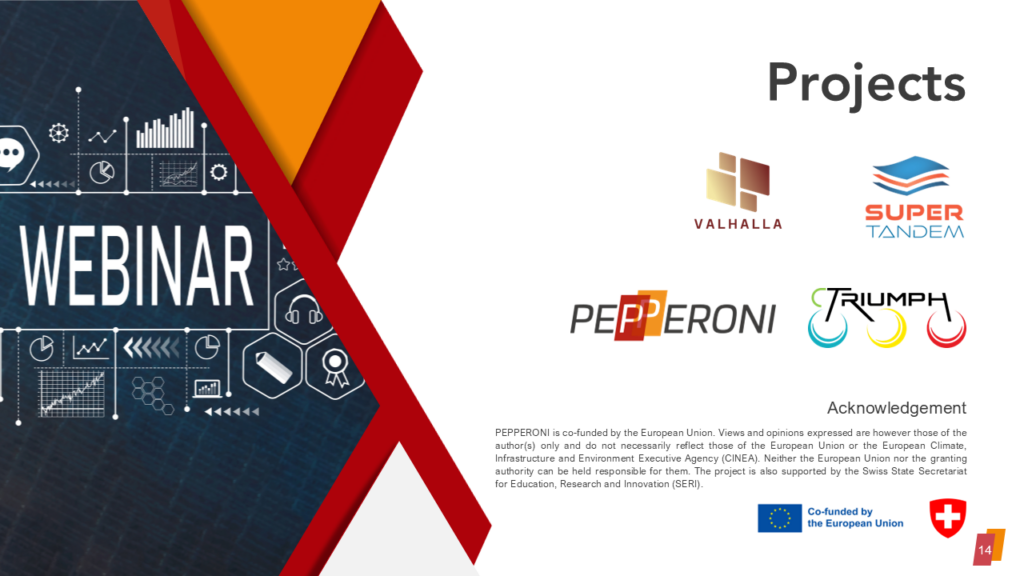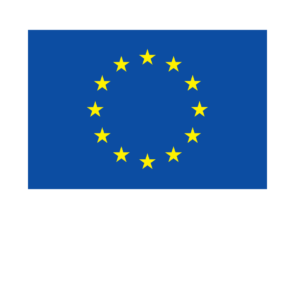On 12 March 2025, PEPPERONI hosted the webinar Leveraging Perovskites: A Journey Through Technologies and EU Projects, featuring leading experts in perovskite photovoltaics. The event showcased four EU-funded projects led by their coordinators: Henk Bolink (VALHALLA, University of Valencia), Sjoerd Veenstra (SuPERTandem, TNO), Bernd Stannowski (PEPPERONI, Helmholtz-Zentrum Berlin), and Hariharsudan Sivaramakrishnan Radhakrishnan (TRIUMPH, imec). The webinar attracted more than 100 attendees from 25 countries worldwide, representing diverse backgrounds, including education and research, PV manufacturing, high-tech, energy and chemical utilities, governmental institutions, equipment manufacturers, and media. Participants ranged from early-stage and senior researchers, engineers and developers, business and project managers to directors and R&D leaders.
Exploring perovskite technologies across TRL levels
Joanna Plesniak (accelopment, Switzerland) introduced the session with an overview of European perovskite research, setting a stage for a deeper dive into the latest advancements from featured projects, that span Technology Readiness Levels (TRLs) from 3 to 7:
- TRL 3: Experimental proof of concept
- TRL 4-5: Validation of technology in the lab and relevant environments
- TRL 6-7: Prototype demonstration and system integration in operational settings
Each speaker presented their respective projects, showcasing advancements in perovskite technology and their potential impact on the renewable energy sector.

Henk Bolink: Vacuum-processed perovskites for single junction solar cells
Henk Bolink delved into vacuum-processed perovskites for single-junction solar cells, beginning with an introduction to inorganic vs. organic semiconductors and the fundamental properties of perovskites. He highlighted insights from the VALHALLA project, including solvent-free processing methods, novel deposition techniques, and improved device performance. His presentation featured key developments in:
- Environmentally friendly processing without toxic and high-boiling point solvents
- Advanced deposition methods
- Performance results for various PV devices, including flexible (cells on foils) and semi-transparent PV

Sjoerd Veenstra: SuPERTandem– advancing all-perovskite tandem solar modules
Sjoerd Veenstra provided an update on the SuPERTandem project, aimed at developing all-perovskite tandem solar modules. His presentation covered core research activities focused on materials, devices, upscaling, and packaging. Key topics included:
- Development of transport and recombination layers with emphasis on deposition methods and intermixing prevention
- Module scale-up processes, including slot-die coating technology
- Progress in wide-bandgap and narrow-bandgap perovskite absorbers as well as bifacial tandem devices for dual-sided illumination
- Stability testing and performance improvements in all-perovskite tandem architectures

Bernd Stannowski: PEPPERONI – overcoming challenges in perovskite/silicon tandem cells
Bernd Stannowski presented the PEPPERONI project, addressing challenges in developing industrial perovskite/silicon tandem cells. He introduced the potential efficiency improvements of tandem cells beyond the limits of silicon. He detailed two main upscaling approaches for the perovskite as developed within PEPPERONI:
- Vacuum-based (dry) processing by physical vapor deposition/evaporation
- Solution-based processing by slot-die coating
Bernd discussed current challenges in upscaling processes and advancements in equipment development for the pilot line and elaborated on the project’s progress, highlighting the recent achievement announced by Qcells: reaching TRL 6 with an efficiency of 28.6% on a full-area M10 perovskite-silicon tandem cell.

Hariharsudan Sivaramakrishnan Radhakrishnan: TRIUMPH – pioneering perovskite/silicon triple junction devices
The final presentation was delivered by Hariharsudan Sivaramakrishnan Radhakrishnan on the TRIUMPH project, which is pioneering perovskite/silicon-based triple junction (3J) devices. The project explores whether 3J solar cells can achieve significantly higher efficiencies while still being cost-effective. Hari explained the characteristics of 3J solar cells and the key challenges involved in their development. Triple junction research can benefit from Pk single-junction and Si/Pk tandem research.
TRIUMPH’s presentation touched upon the following topics:
- Developing and processing photo-stable and efficient ultra-wide bandgap perovskite (Eg > 1.9 eV) top cell is a key challenge
- Triple junction cells with efficiencies >30% on 1 cm2 and >16% on 60 cm2 were achieved
- Current management of the sub-cells and improved transport layers are needed for achieving >33%
- Scaling up to 100 cm2 while minimizing losses is being investigated
- Approaches for indium-reduced triple junction devices and design for recycling have been explored with success.
Key discussions and insights
The webinar underscored the significant role EU-funded projects play in advancing perovskite PV technologies towards commercialisation. The event also received highly positive feedback from the audience, who actively engaged with the speakers through insightful questions and discussions. Some key exchanges included:
What is the new method for ion mobilities? Henk explained that it is based on impedance spectroscopy.
In the sequential evaporation process, why are three sources used for FAI evaporation? Henk responded that this helps increase deposition rates.
Is the direct deposition of the SAM on the TCO for the recombination junction avoided due to homogeneity issues? Have you looked into any parasitic NIR losses as a result of the TCO over PEDOT: PSS? Sjoerd confirmed that homogeneous SAM deposition is crucial for large-area devices and that a buried metal-oxide layer helps mitigate non-conformal SAM layers. He also explained that optoelectronic modelling is used to analyze the effects of TCO and PEDOT: PSS-induced parasitic losses.
In the photostability testing of tandems at 45 degrees, is perovskite tested separately or in tandem, and will degradation rates differ? Bernd responded that testing is primarily conducted on single-junction perovskites but will also include tandem structures and large-area testing.
Have passivation strategies been implemented at the M10 scale, and is thermal evaporation used for SAM deposition? Bernd noted that surface and bulk passivation are crucial for increasing Voc in evaporated perovskites, and this is work in progress.
For the middle junction, is adding Sn to the B-site on the roadmap since a narrower gap is needed than what FAPI alone can achieve? Hari highlighted that adding Sn is challenging due to stability concerns, so they continue working with pure Pb-based FAPI middle cells.



